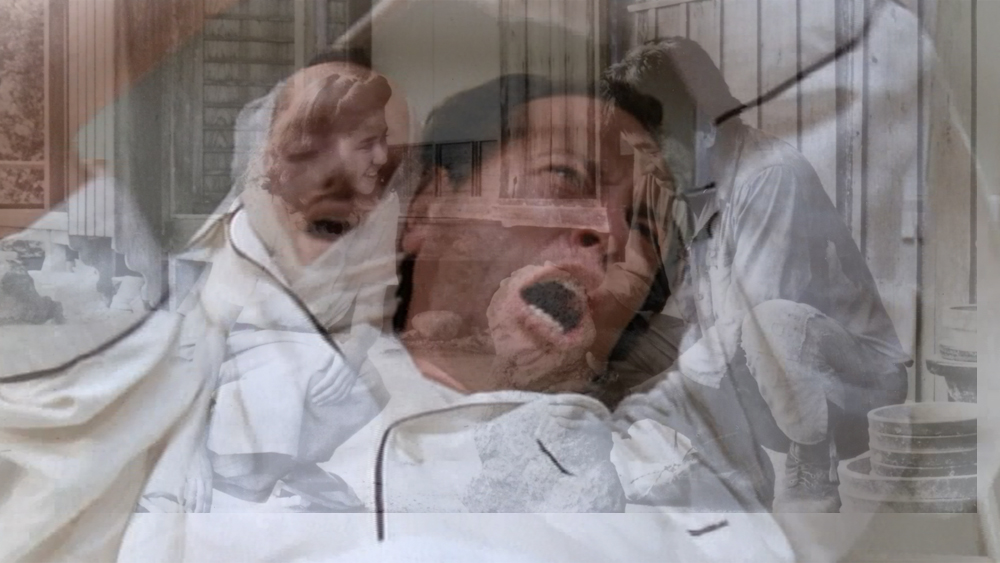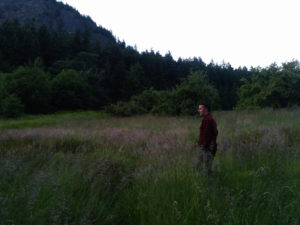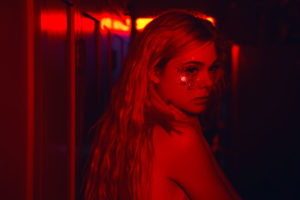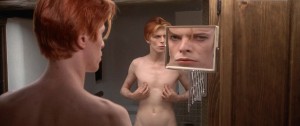
Especially in contemporary times, sickness is a product of external conditions, of cultural context, of socio-political actions you don’t have a great deal of control over. It’s the external threat manifested internally, breaking down the barriers of your personhood and slithering inside you; viruses, germs, radiation, the stress that causes nervous breakdowns and PTSD, these are all the world coming inside of you and stopping your body from working properly. The two movies I watched for this entry are, on the surface, very different (a recurring feature in this series): How to Get Ahead in Advertising is a biting black comedy about marketing, and Black Rain is a realist drama about the aftermath of the atomic bombings of Hiroshima and Nagasaki. But what they share is an obsession with disease, both of the physical and mental kinds, as created by Western culture.
How to Get Ahead in Advertising focuses squarely on an ad exec who, suffering from the stress of trying to perfect his campaign for an anti-pimple and boil cream, develops a boil on his neck that soon becomes sentient and takes over his life. It hits familiar beats early and often – yuppie grotesquerie, anti-corporate speechifying, a gleefully nihilistic declaration of our own powerlessness before capitalism – but what sets it apart is both its outsized approach to the material and surprisingly subtle bits of character work. The boil is absolutely disgusting, and Richard E. Grant plays that up as he makes himself look not just sick, but dying. As he has a crisis of conscience about what his job entails, about the entire nature of an entitled “developed” world, his boil takes on all of his evil and callous traits, bifurcating the loving but evil man of the beginning into the consumer and the salesman.
It’s all a metaphor – thudding, sledgehammer-obvious, but effective nonetheless – for the ailments of Western culture, of needing everything new, new, new, of “health food” that’s just repackaged junk with a sticker that advertises what it’s low or high in. Richard E. Grant’s Bagley is made delirious by constant lying, by his career of deception, by his role in the system exposing him to the mechanics lying behind the pretty exterior. So when the film halfway through stops being a bleak, bleak comedy and becomes and bleak, bleak tragedy, it feels not only natural but inevitable. As the hope for Bagley’s goodness to win out fades into impossibility, the exaggerated evil of the early goings curdles into all-too-real mundanity, our hero extinguished by his part in the intricate clockwork of capitalism. When heroic music swells behind an ironic, overwrought monologue about the moral rightness of consumers being able to buy any cigarette brand they want, it’s not a belly laugh so much as a confirmation of the sickness’ victory. Even when it’s so obvious, in our faces, disgusting, there’s nothing we can do to fight against it.
Black Rain, instead of being fantastical and metaphoric, chooses to ground itself in the true consequences of the atomic bombings. The sickness being discussed is real, powerful, and life destroying, both in the immediate aftermath of the bombings and as the years go on, with the survivors suffering from the mental and physical trauma they experienced at the hands of the American military. As radiation sickness claims the lives of direct and indirect exposure victims, the talk of a “will to live” seems less and less meaningful, everyone caught up in another system they can’t break out of. Ostracized by the same groups of people who professed to care about their plight just five years before, the survivors are scarred by the evils of the bombings, depicted harrowingly in unflinching flashbacks that show mothers cradling burned children, people violently lashing out while trapped in debris, and a man who cannot recognize his own brother because he’s been so terribly burned.
One of the most powerful and moving subplots of the movie is that of Yasuko, a secondary exposure survivor who lived through the black rain, and her inability to find a suitor that will stay with her, all of them fearing the potential of disease before it even manifests, like she’s been invisibly branded with the evil of the bombs. The only person she can connect with is Yuichi, a veteran next door who suffers from PTSD that causes him to attack passing cars, imagining them to be tanks. Though they’re effected by different kinds of sickness, they are both marked with the stain of the West, forced upon them during war, and they find comfort in each other in scenes that are both painful and moving. In one of the only breaks the film has from realism, Yuichi is flooded with the white of a spotlight as he describes his experience in the war, writhing in fear and pain as Yasuko watches in the background, not trying to stop him, and not judging him. It’s a distressing yet tender moment, and their connection makes their inevitable suffering all the more painful and completely realized. Neither of them can escape their encounters in the past, and the pathogen of that is so strong that they cannot scrub it off.
So which sickness wins out? I feel like the answer lies a bit in my own bias, as despite Black Rain’s magnitude and weight, it was harder to connect with because of my cultural background. It says a lot that the translation I saw had translator notes multiple times throughout; this is a distinctly Japanese movie, one that requires knowledge of Japanese cultural mores to fully appreciate and “get”. I could understand that pain to a degree, but the impression the atomic bombings left on Japan is something I can never fully internalize, being white and from America. In a more subtle sense, the way the characters interact requires an almost instinctual understanding of cultural social cues and forms of interaction and expression to fully unpack their meanings, which, again, I can only do so much with. Throughout the film, I was moved, but also found myself distanced, having to intellectually intuit instead of naturally understand.
How to Get Ahead in Advertising is probably the “worse” movie from an objective standpoint (if you believe in that sort of thing), and certainly less important, but its critiques cut me to the core. It’s not that I hadn’t heard them before, it’s that, despite the film’s reputation for a lack of nuance, I saw avenues and pathways in the critiques that were singularly smart and insightful. Its tragedy resonated in me, both as an ardent anti-capitalist and a sad, melancholy, and nihilistically-inclined person. So pitting them against one another, I have to say that How to Get Ahead in Advertising hit me in a stronger spot, but this wasn’t the knock-out easy victory of my first round. Both films deserve a watch, even if one has to be declared the winner.
The Winner: How to Get Ahead in Advertising
—
Both Black Rain and How to Get Ahead in Advertising are in print and available for purchase on Amazon and for rental at your local video store (presumably), while only How to Get Ahead in Advertising is available through Netflix.
Black Rain; directed by Shôhei Imamura; written by Shôhei Imamura and Toshirô Ishidô; based on the novel Black Rain by Masuji Ibuse; starring Yoshiko Tanaka, Kazuo Kitamura, Etsuko Ichihara, and Shôichi Ozara; 123 minutes.
How to Get Ahead in Advertising; written and directed by Bruce Robinson; starring Richard E. Grant, Rachel Ward, Richard Wilson, and Jacqueline Tong; 94 minutes.



 Derek
Derek
 Isabelle
Isabelle